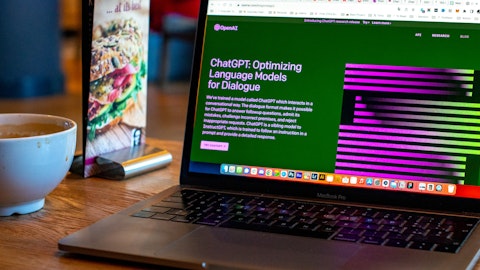Operator: Thank you. And our next question today comes from Scott Davis of Melius Research. Please go ahead.
Scott Davis: Hi, good morning, guys.
George Oliver: Good morning.
Scott Davis: Can you guy’s give us kind of help us understand the materiality of data centers. It seems obviously really bullish commentary we’ve heard from many folks, and don’t always think about JCI in the data center business, but certainly, you guys have a meaningful presence. So can you help size that for us?
George Oliver: Yes, Scott, let me take that one. When you look at — as we look at data centers, we’ve been obviously, reinvesting in all of our applied product to have the full portfolio to be able to capitalize on what we see to be incredible growth here over the decade. And so when you look at a typical data centers, let’s take a 100-megawatt data center that requires roughly about 30,000 tons of cooling. That can be served. Right now, the big trend is air-cooled chillers. We’re the leader in the space with the investments that we’ve made and being able to deliver on those capabilities and that’s where we’re seeing significant growth in serving that set of customers. And so it can either be air cooled or water cooled. Of course, water cooled we’re in a strong position.
So roughly about 30,000 tons of cooling. So when you look at the market at 2024, we’re projecting somewhere at 15 gigawatts to 20 gigawatts, which will amount to about five tons of cooling needs. Now because of our position with our strong portfolio of the full technology to serve these, we believe we’re positioned to get, let’s say, half of that volume going forward, which — the overall volume would be greater than $2 billion. And so for us, this has been a position of incredible strength. A lot of that is because of our multigenerational developments we’ve made at our engineering center. Just a comment on that, we’ve — just in the last 90 days, we’ve had customers representing over 20% of the US GDP at our technology center because as we’re laying out long-term plans with our customers, we’re making sure we’re positioned with the applications that ultimately achieve their needs.
And so it is a very attractive space for us, Scott. And then from a service standpoint, once we get that unit installed, we’re getting very strong service growth on top of that, which will then be over the lifecycle of that installation.
Scott Davis: That’s helpful, George. And when you think about putting servicing and AI kind of heat-intensive data center, is that higher margin — A, is a higher margin? But B, is a higher margin, if it is, is it higher margin because of the complexity or because of just the scale that you’re just getting so much more content into that facility?
George Oliver: Yes, I think it’s both. I mean the criticality of the applications that we provide and then the ability to be able to operate within those conditions. And then from a data standpoint, making sure that we’re secure relative to what we do and how we manage the data that ultimately delivers the outcomes that we can deliver. Certainly, the work that we’ve done around OpenBlue and the cloud-based technology there, none of that was absolutely — was not interrupted at all with our cyber incident. So a lot of that is, we believe it’s high-margin service opportunity not only at the equipment level, but then with the use of all of the data to enhance how that equipment is actually operated in their environment.
Operator: Thank you. And our next question today comes from Steve Tusa with JPMorgan. Please go ahead.
Steve Tusa: Hi. Good morning.
George Oliver: Good morning, Steve.
Steve Tusa: Can you just provide a little bit more detail around the impact from the cyber-attack? I mean, I think you said $0.04 in the fourth quarter, but it was kind of late in the fourth quarter. And then in particular, which businesses it impacted just kind of the mechanics of the thing? And then just clarify what you’re saying in the first quarter, I think you said $200 million in cash, but then $0.02 of earnings, I might have missed. I’m not sure I can reconcile like all those numbers. So maybe just a little more mechanical detail on the impact of the cyber-attack?
George Oliver: Yes. Let me give you some of the numbers. In Q4, we believe that the impact on the top-line was about 1%. It will be the same in Q1. What you have going on, Steve, I would go to the EPS impact in a second is what you lose in Q4, you recover some of it in Q1, right? That’s why you have those numbers going on. So 1% in revenue in Q4 and in Q1. The EPS impact in Q4 is about $0.04 and the impact in Q1 about $0.02. What is mainly impacted is everything which is short cycle, if you need to satisfy demand for something that you need to have in inventory, if you don’t have it, you lose it, that’s where the impact will be. My $200 million impact in cash is lower collection in the first quarter because we’re not able to build immediately as we could not be immediately then that has delayed collection. That’s the $200 million, Steve.




